Travel
Yap Day: One of the most authentic cultural celebrations in the world
Yap Visitors Bureau February 11, 2025
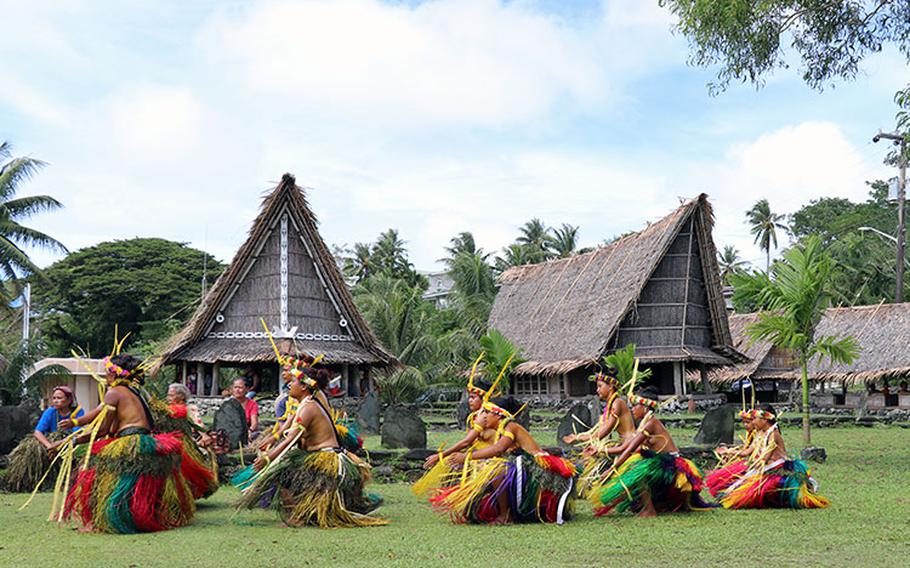
Women’s standing dance performed at the Living History Museum, Colonia, Yap (Photo courtesy of Yap Visitors Bureau)
The long, low sound of the conch shell announces the beginning of Yap Day, an annual holiday set aside to celebrate the unique culture of this remote island, one of the best-preserved in the entire Pacific region.

(Map by Stripes Guam)
I was among those gathering together for the annual “mit-mit” hosted by a different village every year on or around March 1st.
During the weeks leading up to the event, there was talk among my friends about the intense practice sessions they were involved in every evening for nearly a year to prepare for their village’s dance, or “churu.” Fines are levied if they miss a practice session. This is serious business.
All of the dances are a form of oral history that tells stories about ancient seafaring journeys, conquests, myths, and exploration in sitting dances, kneeling dances, standing dances, and stick dances.
Each is accompanied by a loud, often wailing, chant in a long-forgotten language by a line of solemn dancers wearing a traditional dress like multicolored hibiscus-grass skirts for the women and intricately wrapped loincloths called thu’us for the men, ornamental flower crowns called nunus, and leis called marmars.

Yapese man wearing traditional thu’u and standing in front of stone money. (Photo courtesy of Yap Visitors Bureau)
Their bodies are covered with coconut oil and yellow turmeric powder that provides a golden sheen.
On the first day, I arrived around noon at the Living History Museum in the middle of the island’s only town, Colonia. I watched, while booths were being set up to sell local food, like breadfruit, pounded and wrapped and steamed in banana leaves, and sweet bread made with one of the more than three dozen varieties of bananas that grow on the island.
I saw jewelry made of coconut shells and the polished shell of sea turtles legally caught for food during certain times of the year; hand-carved household items like the tall cup made from a thick stalk of bamboo that I use to hold kitchen utensils; and hot sauce, dried lemongrass, and lemon powder all made from local ingredients.
My favorite is breadfruit chips, small rounds baked to crispness. And don’t forget to pick up a cold coconut with a straw poked through one of the “eyes.” The sweet water inside will keep you hydrated all day.
Day one is devoted to the opening ceremony with the police doing color guard duty, the governor and other officials giving speeches, and a teenage girl leading everyone in singing the national anthem.
I found a seat on the raised stone platform covered with stone backrests to watch the first dance that’s performed at the end of the day against the backdrop of the museum’s traditional structures made without nails of mahogany, coconut rope, and dried palm fronds.
One of the most memorable Yap Days for me was held in the northern municipality of Gagil, the site of one of the island’s most beautiful traditional community houses and stone money banks. My camera got a workout that day.
The day’s activities included the ceremonial stone money carry recognizing the seafarers who traveled 250 miles across the ocean to Palau by canoe centuries ago to quarry and bring back the massive rounds used as currency known as stone money.
Next was the entrance of four men, each carrying an item of cultural importance including a large betel nut pounder, shell money, and other forms of valuable currency.
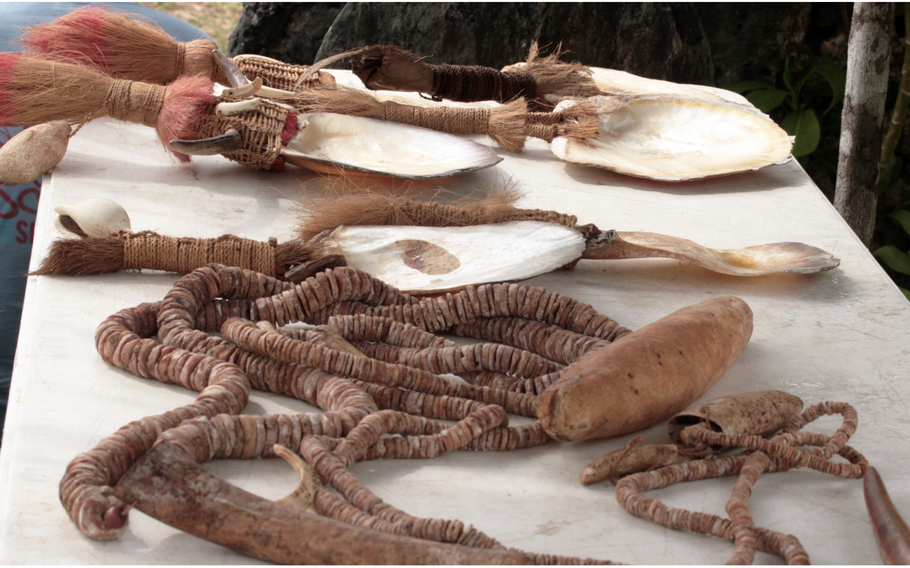
Traditional shell money displayed during Yap Day. (Photo courtesy of Yap Visitors Bureau)
All of the dances are a form of oral history that tells stories about ancient seafaring journeys, conquests, myths, and exploration in sitting dances, kneeling dances, standing dances, and stick dances.
Each is accompanied by a loud, often wailing, chant in a long-forgotten language by a line of solemn dancers wearing a traditional dress like multicolored hibiscus-grass skirts for the women and intricately wrapped loincloths called thu’us for the men, ornamental flower crowns called nunus, and leis called marmars.
Their bodies are covered with coconut oil and yellow turmeric powder that provides a golden sheen.
On the first day, I arrived around noon at the Living History Museum in the middle of the island’s only town, Colonia. I watched, while booths were being set up to sell local food, like breadfruit, pounded and wrapped and steamed in banana leaves, and sweet bread made with one of the more than three dozen varieties of bananas that grow on the island.
I saw jewelry made of coconut shells and the polished shell of sea turtles legally caught for food during certain times of the year; hand-carved household items like the tall cup made from a thick stalk of bamboo that I use to hold kitchen utensils; and hot sauce, dried lemongrass, and lemon powder all made from local ingredients.
My favorite is breadfruit chips, small rounds baked to crispness. And don’t forget to pick up a cold coconut with a straw poked through one of the “eyes.” The sweet water inside will keep you hydrated all day.
Day one is devoted to the opening ceremony with the police doing color guard duty, the governor and other officials giving speeches, and a teenage girl leading everyone in singing the national anthem.
I found a seat on the raised stone platform covered with stone backrests to watch the first dance that’s performed at the end of the day against the backdrop of the museum’s traditional structures made without nails of mahogany, coconut rope, and dried palm fronds.
One of the most memorable Yap Days for me was held in the northern municipality of Gagil, the site of one of the island’s most beautiful traditional community houses and stone money banks. My camera got a workout that day.
The day’s activities included the ceremonial stone money carry recognizing the seafarers who traveled 250 miles across the ocean to Palau by canoe centuries ago to quarry and bring back the massive rounds used as currency known as stone money.
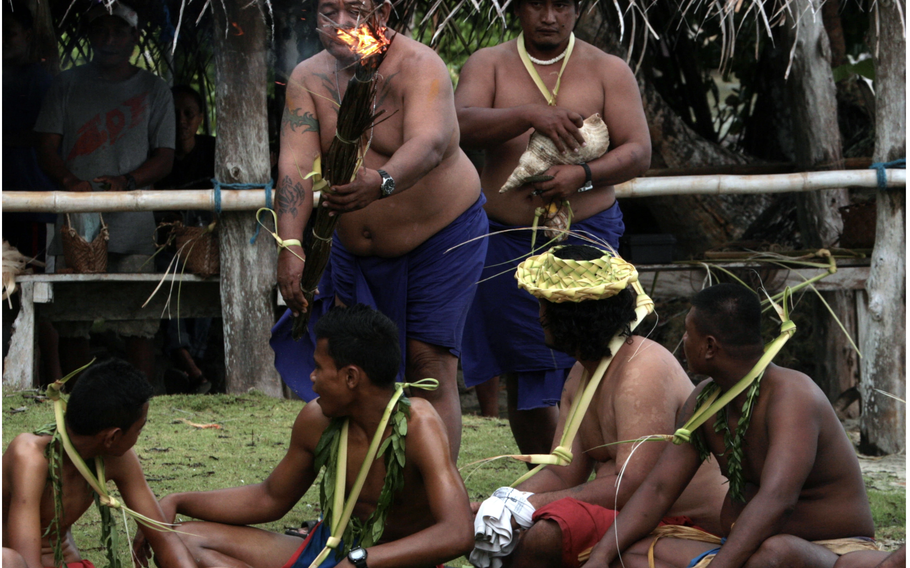
Blessing the crew before the ocean voyage. (Photo courtesy of Yap Visitors Bureau)
Next was the entrance of four men, each carrying an item of cultural importance including a large betel nut pounder, shell money, and other forms of valuable currency.
In between the dances, I wandered around to view traditional skill demonstrations that were also on display with one man making a fish trap of twine and twigs, women weaving baskets of dried palm fronds, and others making nunus.
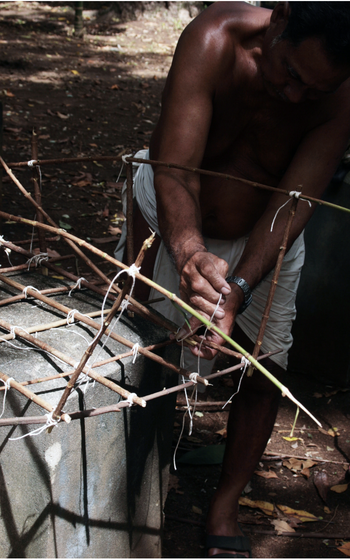
Making a traditional Yapese fish trap. (Photo courtesy of Yap Visitors Bureau)
Another man offered tuba, the fizzy drink made of fermented coconut water. Baskets of watermelon, passion fruit, small bananas, lemons, and other locally grown fruits were set out.
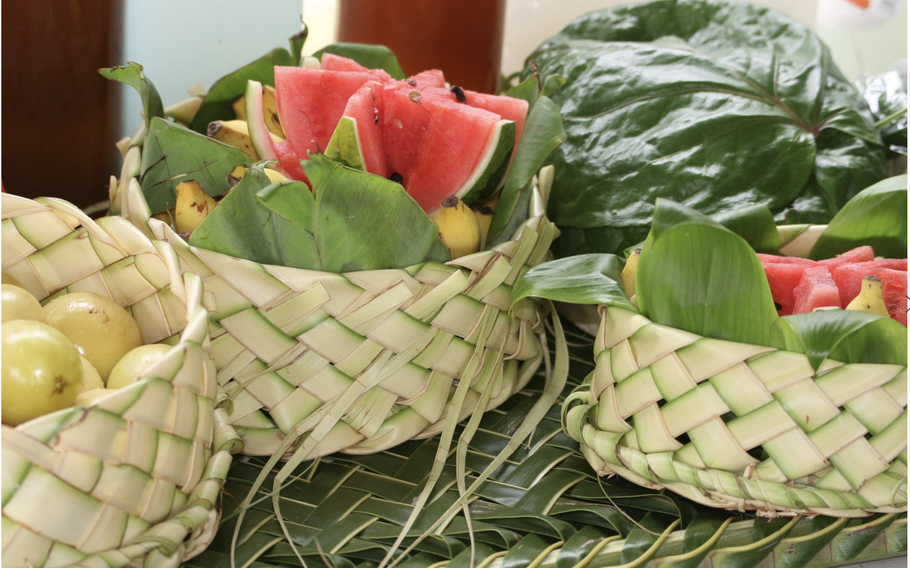
Yapese fruit baskets. (Photo courtesy of Yap Visitors Bureau)
One of the highlights of the day was the races – the men’s betelnut tree climb and the women’s combination foot race and basket-weaving challenge -- accompanied by lots of laughter and loud encouragement from the sidelines.
The third day focused on traditional navigation, canoe carving, and sailing the mahogany and bamboo vessels with visitors invited to take a ride. Nearby a man was carving up a fresh tuna caught that morning for sushi.
By the end of the third day, everyone was tired and I was no exception. But my photos continue to remind me of those unique cultural celebrations and my good fortune to be among the few outsiders who have attended them.
Although visitors to the island are welcomed, Yap Day is not staged for tourists, it is by-Yapese-for-Yapese and therefore one of the most authentic celebrations in the world.
In between the dances, I wandered around to view traditional skill demonstrations that were also on display with one man making a fish trap of twine and twigs, women weaving baskets of dried palm fronds, and others making nunus.
Another man offered tuba, the fizzy drink made of fermented coconut water. Baskets of watermelon, passion fruit, small bananas, lemons, and other locally grown fruits were set out.
One of the highlights of the day was the races – the men’s betelnut tree climb and the women’s combination foot race and basket-weaving challenge -- accompanied by lots of laughter and loud encouragement from the sidelines.
The third day focused on traditional navigation, canoe carving, and sailing the mahogany and bamboo vessels with visitors invited to take a ride. Nearby a man was carving up a fresh tuna caught that morning for sushi.
By the end of the third day, everyone was tired and I was no exception. But my photos continue to remind me of those unique cultural celebrations and my good fortune to be among the few outsiders who have attended them.
Although visitors to the island are welcomed, Yap Day is not staged for tourists, it is by-Yapese-for-Yapese and therefore one of the most authentic celebrations in the world.
ABOUT YAP
Yap is an island in the Federated States of Micronesia, in the Pacific Ocean that is ringed by spectacular coral reefs and famous for its scuba diving with giant manta rays, sharks and mandarin fish. Other key activities on the island include kayaking, hiking, deep-sea fishing and exploring the many World War II historical sites. Yap is also uniquely famous for its stone money (huge disks of stone, which are still used today in major transactions), strong traditional culture and way of life, and welcoming residents. Just a short flight away from Guam or Palau, this Pacific gem is one of the tourism industry’s best kept secrets.
Contact the Yap Visitors Bureau at www.visityap.com for more information.
This article is republished from www.pedacitosblog.com.